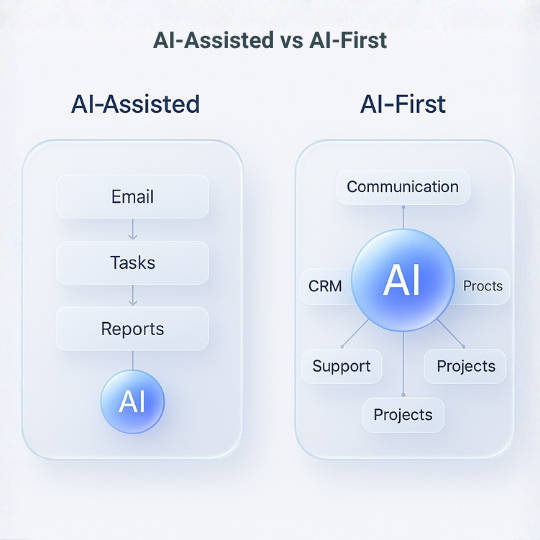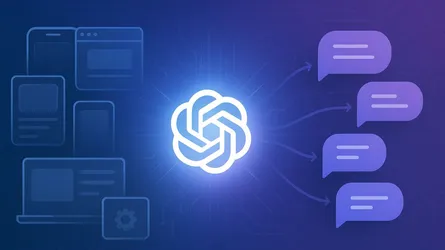Your email client now has AI auto-replies. Your CRM suggests next steps. Your project management tool writes summaries. Congratulations—you’ve bolted AI onto existing workflows.
But imagine if email had been invented after chatGPT existed. Would we still look at separate inbox, sent, and drafts folders? Would we manually search for that message from six months ago? Would we write the same introduction for the tenth time this week?
Of course not. We’d have a context-aware communication assistant that knows your entire history, understands relationships, recognizes priorities, and handles routine correspondence while surfacing only what genuinely needs your attention.
That’s the difference between AI-assisted and AI-first design.
The Incremental Trap
Most companies are stuck in incremental AI adoption mode:
- Add a chatbot to the website
- Implement AI writing suggestions in your editor
- Enable smart sorting in your dashboard
- Automate a few repetitive tasks
These improvements can create value short-term. But in a competative AI landscape, many will quicly fall behind.
When you bolt AI onto systems designed for the pre-AI world, you get:
- Awkward integrations that don’t leverage AI’s full capabilities
- Fragmented experiences where AI helps in some places but not others
- Missed opportunities because the underlying architecture can’t support what AI actually enables
- Diminishing returns as each new AI feature works around existing constraints instead of eliminating them
You’re optimizing for the past while the future demands something entirely different.
What AI-First Really Means
AI-first design starts with a blank slate and one question: “If I were designing this system today, knowing I have a capable AI partner, what would I build?”
Not: “Where can I add AI to improve what exists?”
But: “What becomes possible when AI is foundational, not supplemental?”

The Mental Shift
AI-assisted: We have a workflow. Let’s use AI to make it faster - nothing wrong with this.
AI-first: We have a goal. Let’s design the workflow assuming AI handles everything it’s capable of, and other systems handle everything it’s not.
Example:
AI-assisted customer support: Chatbot answers common questions, escalates complex ones to humans.
AI-first customer support: AI maintains complete context on every customer interaction across all channels. It handles routine issues autonomously, routes complex situations with full context to specialists, and learns from every resolution to improve future responses. Humans focus exclusively on edge cases, relationship building, and strategic account management.
The difference isn’t incremental—it’s architectural.
Why This Mindset Matters
Three reasons AI-first thinking creates competitive advantage:
1. You Ride the Improvement Wave
AI models evolve rapidly. GPT-3 to GPT-5 represented a massive capability jump—and it happened in 18 months.
If you built AI-first: Your systems automatically leverage new capabilities. When the next generation model arrives, your entire product gets smarter overnight. No rewiring required.
2. You Change the Culture
When leadership asks “Where can we add AI?” teams think incrementally. When leadership asks “What would we build differently if AI had always existed?” teams think transformatively.
This cultural shift is where real innovation happens. You discover opportunities invisible to incremental thinking.
The Six AI-First Principles
Use this framework when rethinking products from the ground up:
1. Context is King
Modern AI thrives on rich context. Don’t just give it the immediate task—feed it background, history, relationships, and patterns.
Bad: AI writes email based on subject line. Good: AI writes email knowing recipient relationship, past conversation threads, communication style preferences, and current project context.
Design systems that accumulate and provide context automatically.

2. Real-Time is a Workaround, Not a Given
AI doesn’t inherently know “now” unless you architect for it. Most models work with snapshots of data, not live streams.
Implication: Build data pipelines that continuously update AI context. Don’t assume it knows what just happened—design systems that tell it.
3. Ride the Improvement Wave
Architect so model upgrades automatically improve your product without code changes.
How: Abstract AI capabilities behind interfaces. When better models emerge, swap them in without touching business logic. Your product improves while you sleep.
4. AI is a Learner, Not a Knower
Out-of-the-box AI is generically capable. AI fine-tuned for you becomes specifically excellent.
Implication: Design for continuous learning. Capture feedback, collect edge cases, and treat AI like a team member who gets better with training—not a static tool you deploy once.
5. Keep It Simple When You Can
Don’t AI everything just because you can. Use simple rules where they work; save AI for complexity and creativity.
Example: Email sorting by sender domain? Simple rules. Email prioritization by urgency, importance, and deadline inference? AI excels here.
Complexity requires judgment. AI provides judgment. Simple logic provides efficiency. Use the right tool for each job.
6. Know AI’s Limits
You often have to push them to find out but understand that limits will constantly expand.
Implication: Design human-in-the-loop for critical decisions. Build guardrails. Don’t trust AI blindly—architect for its actual capabilities, not aspirational ones.
The Human Layer Matters More, Not Less
AI-first doesn’t mean AI-only. Paradoxically, as AI handles more routine work, human judgment becomes more valuable.
When AI tackles the predictable 80%, humans can focus entirely on the meaningful 20%:
- Strategic decisions requiring business context
- Relationship building and empathy
- Creative problem-solving for novel situations
- Ethical oversight and values alignment

The goal isn’t replacing humans—it’s amplifying human impact by removing everything that shouldn’t require human attention in the first place.
Start Rethinking Today
You don’t need to rebuild everything overnight. Start with these questions for any product or workflow:
1. What routine work could disappear entirely? Not “get faster”—actually disappear because AI handles it autonomously.
2. What becomes possible with complete context? If AI knew everything relevant about this situation, what decisions could it make that currently require human investigation?
3. Where does human judgment genuinely matter? Identify what truly requires human insight, not just what we assume requires it.
4. How would this look if we started from scratch today? Without legacy constraints, what’s the ideal experience?
These questions surface opportunities invisible to incremental thinking. You’ll discover that many “necessary” steps only exist because the systems were designed before AI capabilities existed.
The New Competitive Edge
Five years from now, every company will use AI. The question is: Will you be using AI like everyone else, or will you be using AI like no one else can?
The companies that win won’t be those who added AI fastest. They’ll be those who rethought their products most fundamentally.
AI-first design isn’t just technical evolution—it’s cultural evolution. It requires product leaders willing to question assumptions, designers comfortable reimagining workflows, and engineers ready to build architectures that don’t exist yet.
Start small if you must, but think big. Pick one workflow. Ask: “What would this look like if AI had been there from day one?” Then build that.
Don’t just add AI to what exists—imagine what would exist if AI had been there all along.
Build AI-First Systems That Actually Work
At Infinite Automation, we specialize in AI-first product design and implementation. Not bolting chatbots onto websites—genuinely rethinking workflows from the ground up with AI as foundational infrastructure.
We help product teams move from incremental AI adoption to transformative AI architecture. Our approach combines strategic thinking with practical engineering to build systems that leverage AI’s actual capabilities while acknowledging its real limitations.
Ready to Rethink Your Product?
🎯 AI-First Strategy Session: We’ll analyze one of your core workflows and show you what AI-first redesign could unlock. Most teams discover opportunities worth 10x their current AI investments.
Explore how we’re applying AI-first thinking in industrial automation with CameraVision, or learn more about our approach to transforming businesses with AI.


